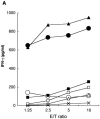Identification of two new HLA-A*1101-restricted tax epitopes recognized by cytotoxic T lymphocytes in an adult T-cell leukemia patient after hematopoietic stem cell transplantation
- PMID: 16014972
- PMCID: PMC1181560
- DOI: 10.1128/JVI.79.15.10088-10092.2005
Identification of two new HLA-A*1101-restricted tax epitopes recognized by cytotoxic T lymphocytes in an adult T-cell leukemia patient after hematopoietic stem cell transplantation
Abstract
We previously reported that Tax-specific CD8(+) cytotoxic T lymphocytes (CTLs), directed to single epitopes restricted by HLA-A2 or A24, expanded in vitro and in vivo in peripheral blood mononuclear cells (PBMC) from some adult T-cell leukemia (ATL) patients after but not before allogeneic hematopoietic stem cell transplantation (HSCT). Here, we demonstrated similar Tax-specific CTL expansion in PBMC from another post-HSCT ATL patient without HLA-A2 or A24, whose CTLs equally recognized two newly identified epitopes, Tax88-96 and Tax272-280, restricted by HLA-A11, suggesting that these immunodominant Tax epitopes are present in the ATL patient in vivo.
Figures







Similar articles
-
Single-cell analysis of T-cell receptor repertoire of HTLV-1 Tax-specific cytotoxic T cells in allogeneic transplant recipients with adult T-cell leukemia/lymphoma.Cancer Res. 2010 Aug 1;70(15):6181-92. doi: 10.1158/0008-5472.CAN-10-0678. Epub 2010 Jul 20. Cancer Res. 2010. PMID: 20647322
-
Human T-cell leukemia virus type-I (HTLV-I)-specific T-cell responses detected using three-divided glutathione-S-transferase (GST)-Tax fusion proteins.J Immunol Methods. 2006 Jun 30;313(1-2):61-73. doi: 10.1016/j.jim.2006.03.013. Epub 2006 May 4. J Immunol Methods. 2006. PMID: 16723135
-
Potential contribution of a novel Tax epitope-specific CD4+ T cells to graft-versus-Tax effect in adult T cell leukemia patients after allogeneic hematopoietic stem cell transplantation.J Immunol. 2013 Apr 15;190(8):4382-92. doi: 10.4049/jimmunol.1202971. Epub 2013 Mar 8. J Immunol. 2013. PMID: 23475215
-
Immunological risks of adult T-cell leukemia at primary HTLV-I infection.Trends Microbiol. 2004 Jul;12(7):346-52. doi: 10.1016/j.tim.2004.05.005. Trends Microbiol. 2004. PMID: 15223062 Review.
-
Maintenance of long remission in adult T-cell leukemia by Tax-targeted vaccine: A hope for disease-preventive therapy.Cancer Sci. 2019 Mar;110(3):849-857. doi: 10.1111/cas.13948. Epub 2019 Feb 19. Cancer Sci. 2019. PMID: 30666755 Free PMC article. Review.
Cited by
-
HTLV-1 Tax-specific memory cytotoxic T lymphocytes in long-term survivors of aggressive-type adult T-cell leukemia/lymphoma.Cancer Med. 2022 Sep;11(17):3238-3250. doi: 10.1002/cam4.4689. Epub 2022 Mar 22. Cancer Med. 2022. PMID: 35315593 Free PMC article.
-
Successful treatment by donor lymphocyte infusion of adult T-cell leukemia/lymphoma relapse following allogeneic hematopoietic stem cell transplantation.Int J Hematol. 2012 Jun;95(6):725-30. doi: 10.1007/s12185-012-1056-3. Epub 2012 Apr 6. Int J Hematol. 2012. PMID: 22481502
-
The roles of acquired and innate immunity in human T-cell leukemia virus type 1-mediated diseases.Front Microbiol. 2012 Sep 3;3:323. doi: 10.3389/fmicb.2012.00323. eCollection 2012. Front Microbiol. 2012. PMID: 22969761 Free PMC article.
-
Impact of host immunity on HTLV-1 pathogenesis: potential of Tax-targeted immunotherapy against ATL.Retrovirology. 2019 Aug 22;16(1):23. doi: 10.1186/s12977-019-0484-z. Retrovirology. 2019. PMID: 31438973 Free PMC article. Review.
-
Short-term cultured autologous peripheral blood mononuclear cells as a potential immunogen to activate Tax-specific CTL response in adult T-cell leukemia patients.Cancer Sci. 2021 Mar;112(3):1161-1172. doi: 10.1111/cas.14800. Epub 2021 Feb 5. Cancer Sci. 2021. PMID: 33410215 Free PMC article.
References
-
- Bieganowska, K., P. Hollsberg, G. J. Buckle, D. G. Lim, T. F. Greten, J. Schneck, J. D. Altman, S. Jacobson, S. L. Ledis, B. Hanchard, J. Chin, O. Morgan, P. A. Roth, and D. A. Hafler. 1999. Direct analysis of viral-specific CD8+ T cells with soluble HLA-A2/Tax11-19 tetramer complexes in patients with human T cell lymphotropic virus-associated myelopathy. J. Immunol. 162:1765-1771. - PubMed
-
- Gomi, S., M. Nakao, F. Niiya, Y. Imamura, K. Kawano, S. Nishizaka, A. Hayashi, Y. Sobao, K. Oizumi, and K. Itoh. 1999. A cyclophilin B gene encodes antigenic epitopes recognized by HLA-A24-restricted and tumor-specific CTLs. J. Immunol. 163:4994-5004. - PubMed
-
- Goulmy, E., R. Schipper, J. Pool, E. Blokland, J. H. Falkenburg, J. Vossen, A. Grathwohl, G. B. Vogelsang, H. C. van Houwelingen, and J. J. van Rood. 1996. Mismatches of minor histocompatibility antigens between HLA-identical donors and recipients and the development of graft-versus-host disease after bone marrow transplantation. N. Engl. J. Med. 334:281-285. - PubMed
-
- Hanabuchi, S., T. Ohashi, Y. Koya, H. Kato, A. Hasegawa, F. Takemura, T. Masuda, and M. Kannagi. 2001. Regression of human T-cell leukemia virus type I (HTLV-I)-associated lymphomas in a rat model: peptide-induced T-cell immunity. J. Natl. Cancer Inst. 93:1775-1783. - PubMed
Publication types
MeSH terms
Substances
LinkOut - more resources
Full Text Sources
Other Literature Sources
Research Materials

